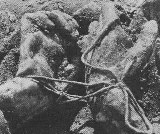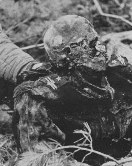In January 2000, Russia's president-elect Vladimir Putin telephoned Polish President Aleksander Kwaśniewski to inform him of the discovery of a mass grave thought to contain the bodies of Poles murdered by Soviet forces during the Second World War.
The grave was found near Smolensk, close to Katyń, where some 4000 Polish officers had already been found. Between 15,000 and 25,700 people were executed in April and May of 1940 following the Soviet invasion, and most of the bodies have never been recovered. The Katyń massacre, as the event is known, has long served as a symbol of Soviet crimes against Poland.
Monuments and martyrs
As part of death rituals in many societies and religions, the bodies of the deceased are put on display. This constitutes an integral part of the grieving process and dispels any questions as to whether the person is indeed dead. There often seems to be an almost pathological need to witness death, and anonymous death is regarded as the greatest insult a human being could be subjected to. It is no coincidence that the loss of many bodies in the deep mud of the trenches and battlegrounds of the First World War was followed by a boom in the monument industry.
Public executions and display of the criminal / victim served primarily as a warning to the populace of the strength of the ruling authority. Ironically, however, it also created martyrs, particularly in times of foreign occupation, thus strengthening the resistance of the occupied population.
Katyń occupies a special place in Poland's already martyr-packed pantheon. After the defeat of Polish forces at the hands of the Nazi and Soviet forces in the autumn of 1939, both allies took thousands of prisoners of war. The Soviet side received a majority of the Polish army's officer corps (whether they had them all in the first place or whether a portion was handed over by the Nazis remains unclear).
Many were not career soldiers but rather reservists, called away from their various professions (doctors, lawyers, engineers, etc) and represented Poland's elite. They were interned in several camps (Ostashkov, Katyń, Mednoe and Kharkiv), but had vanished by the time Germany had turned against its former ally in 1941 and General Władysław Anders was invited to re-form the Polish army on Soviet soil.
The discovery of mass graves
 During their rapid advance, the Germans came across mass graves in the Katyń Forest, a wooded area near Gneizdovo village and a short distance from Smolensk. In 1943, they exhumed around 4000 corpses, dressed in Polish army uniforms, with their hands bound behind their backs, apparently killed by a bullet through the head. As was their habit, the Germans meticulously documented their discovery and made it public as irrefutable proof of Soviet barbarity.
During their rapid advance, the Germans came across mass graves in the Katyń Forest, a wooded area near Gneizdovo village and a short distance from Smolensk. In 1943, they exhumed around 4000 corpses, dressed in Polish army uniforms, with their hands bound behind their backs, apparently killed by a bullet through the head. As was their habit, the Germans meticulously documented their discovery and made it public as irrefutable proof of Soviet barbarity.
But it is, after all, the victors who dictate history, and after regaining the territory in 1944, Soviet authorities exhumed the bodies again and thereafter steadfastly maintained that the Germans had in fact committed the crime following their advance. The fact that German-manufactured bullets had been used in the executions was their crucial piece of evidence.
Poland saw more than its share of death and destruction during the Second World War, but not so much that several thousand missing officers went unnoticed. Yet, despite being proclaimed a crime carried out by fascists, there were no further investigations into the graves; there were no public enquiries and all signs of mourning were discouraged or banned.
The years of silence
Katyń was a dirty word—to both the rulers and their unenthusiastic subjects. Through its persistent silence the Soviet government essentially confirmed what was rumoured to be true. Yet asking questions about a political crime was hardly wise in the immediate post-war period. None of this meant that the crime had actually been forgotten. Crosses were surreptitiously raised at night in the Powąski military cemetery in Warsaw, only to be dismantled by irate authorities in the morning. The dead of Katyń were regarded as the lost future of Poland—powerful ghosts for any regime to fight.
Ideally, history de-mystifies past events. The field of Soviet studies, including Soviet history, has always been an imprecise science mainly due to the lack of complete information. Aerial photography has contributed significantly to the establishment of certain facts. Over-flies by the Luftwaffe quite clearly demonstrate that the substantial disturbances of the earth's surface, which would subsequently be determined to be some of the burial sites, pre-date the German advance into the area. Therefore, it is difficult to escape the conclusion that the Soviets were indeed responsible.
God's Eye is clearly a work that was driven by passion. The author recounts numerous heart-wrenching episodes from all sides—the victims, the witnesses and the surviving family members—which relate the pain and suffering this crime caused. Also evident is the admirable dedication of those involved in researching various aspects of the case. Wacław Godziemba-Maliszewski's work as an amateur, though certainly not amateurish, historian is remarkable both for its skill and results. His patience and perseverance must be applauded and his studies acknowledged as invaluable.
Unfortunately, God's Eye makes the fascinating and important contribution of aerial photography to historical studies, and to this case in particular, peripheral. Instead, the author concentrates on Maliszewski's struggles to have his analysis recognised and credited. He also repeatedly chastises the dismissive attitude of the Allied governments, particularly the US, toward the crime. There is also a great deal of criticism levelled at the post-Communist Polish administration and academia. While the lack of action or thorough inquiry by any party may be troubling, even contemptible and horrifying, it is also hardly new or surprising. And—like the majority of mass murders—it is not personal.
The work also lacks clarity regarding its intended audience. Several times the author refers to the US government as "ours," presumably indicating an American audience. However, the event and its greater significance, be it in terms of Polish history and society, international relations, American society or Soviet history, are inadequately established for an uninitiated audience. At the same time, it offers little new or relevant information for an academic, or even an experienced, reader.
Katyń today
Sixty years later, Katyń still stirs passions in Poland. Addressing the Sejm in autumn 2000, Prime Minister Jerzy Buzek declared, "These were not only Polish officers, Poland's elite, who were buried in the Katyń graves. For many years, Polish sovereignty was buried there as well." Around the same time, Poles and Russians gathered in Tver to open a state memorial complex at Mednoe, commemorating the 6313 Poles and more than 9000 Russians who were killed there by the NKVD during the Second World War. Buzek also noted that the official declaration of cooperation of the Russian side that came early in the 1990s was a "milestone in the work on unveiling the truth about Katyń." He didn't add that the admission of responsibility is really what had been key. The same year, Leon Kieres, head of Poland's National Remembrance Institute, mentioned the possibility of launching a formal investigation into the murder of the Polish officers.
As the author of God's Eye rightly notes, the pursuit of the Katyń case has been subject to the currents and whims of international relations and domestic policy, in all the states involved. Over the years the physical evidence has repeatedly been interfered with and has certainly eroded while documentary evidence has surfaced. Is the memory of the victims being desecrated, as their graves have been, because they are turning into (or being relegated to) a historical case study? Or because there no longer seems to be a pressing need to view the bodies and unmask the criminals? It would seem that within Poland the majority of people want to move forward rather than remain with the ghosts.

|
It is doubtful that the dead of Katyń will be forgotten, and they remain Poland's lost generation. The crime was a political one and for many years their deaths served various political causes. Perhaps the wake should be over and they should rest in peace.
Joanna Rohozińska, 19 March 2001
Moving on:
- Buy God's Eye from Amazon.com
- Archived book reviews
- Browse through the CER eBookstore for electronic books
- Buy English-language books on Central and Eastern Europe through CER
- Return to CER front page




